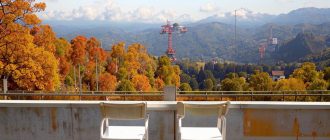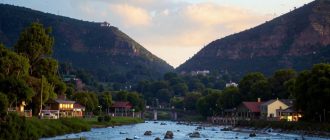How to prepare for a mountain hike? Why can not take climbing lightly?
Experienced travelers answer.
Man in modern society is overly dependent on trends and social approval of others. What some of us dare to do for the sake of likes on social media is often shocking. Unfortunately, at such moments people turn off the instinct of self-preservation and turn on the hunt for increased attention to themselves from the outside. The main thing becomes not the emotion that you can get here and now, to see the beauty and keep it for yourself and your loved ones, but the collection of all the rewards in the world for “outstanding merits”.
The instinct of self-preservation in the 21st century has greatly diminished, it is almost non-existent. We have nothing to fear: it is impossible to meet a saber-toothed tiger in the central park, and the environment in cities is as friendly as possible. And there is more information about everything. Many things – such as singing, drawing, programming, sports – are easier to learn from scratch now than they were 15 years ago.
But there is another side of the coin. People are beginning to confuse freedom of choice with permissiveness. One of the brightest examples of such substitution of concepts is mountains.

Why is mountain tourism so popular in recent years?

member of the international association of cave explorers CAVEX, world record holder for height difference.
First of all, I would not say that it is mountain tourism – probably it is the popularity of climbing such peaks as Elbrus and Kazbek. They are significant for our compatriots.
– Elbrus is the highest mountain in Europe, so most people climbing or trying to climb there feel a feeling close to being mountaineers. Probably the word combination “mountain tourism” is not quite right. Although, of course, there are quite a lot of groups going out on mountain-tourist routes.
Elbrus is a famous two-headed mountain in the Caucasus. The height of the western peak is 5642 meters above sea level, and the eastern peak is 5621 meters. It is the highest mountain peak in Europe. Elbrus is rightfully included in the list of “seven peaks”.
– This is explained, in my opinion, by the fact that people are tired of the “eat, sleep, drink, snack and go to work” lifestyle. We are now seeing a tremendous surge of interest in many cyclic sports, in sports in general. Amateur starts, marathons and half-marathons are gaining a large number of participants – it is insanely popular. Amateur cross-country skiing competitions are actively developing, and such things as mountaineering climbs harmoniously fit in there.
In my opinion, everything is obvious: people are interested not only in standard pastime, but also in something close to the words “extreme”, “sportiness” and so on. A general trend that is almost impossible to avoid. Well, it probably doesn’t need to be avoided. It is really interesting and beautiful. There is an opportunity to see a lot of curious things and dive into semi-extreme things.

Why is the death rate in the mountains increasing? Are people to blame for this?
– The question, in my opinion, is a complicated one. I wouldn’t say it’s increasing. If we look at the percentage ratio, now the number of people climbing mountains is incomparably higher. In the 90s there were much fewer of them, so I disagree with you here.
If we analyze accidents, it is usually human error: wrong calculation, wrong climbing logistics, wrong equipment selection, lack of experience. I could go on for a long time. I can also include the factor that many people who go to the mountains do not fully understand the seriousness of the mountains themselves and the danger that awaits them.
When you look at the same Elbrus from below in good weather, you get the impression that everything is close and the mountain is simple. Slap-slap-slap-slap, and you have reached the top – what is difficult here? But at another moment, when weather conditions change, we realize that the mountain is very dangerous, treacherous and cruel. It does not forgive mistakes.

There is a certain devaluation of the mountain’s dangers. People come back, having climbed in good weather, in favorable conditions with a lot of guides, and say: “Everything is easy there, nothing complicated, you can climb to the top in shorts”. Many races that are organized in high mountains are interesting and wonderful, but people do not realize that well-trained people participate in them, let alone win. An ordinary person, even a very good athlete, who has not devoted time to such a specialized training process, will also fail.
The fault lies not only with those who climb the peaks without much experience, but also with ourselves – those who have been going to the mountains for a long time, understand them and feel all the danger. We talk more often about how cool we are, how awesome we are, how we’ve done this, passed here and there. I’ve been involved in a lot of rescues this year, for example, and I want to talk about that now. To talk about the fact that mountains are really dangerous, they are not as easy and accessible as many people think from here, from the plain.
– Literally 10-15 years ago, no one could even imagine such a thing, and now the situation has changed: you pay money to a travel company that organizes some “trips”, and you can safely go to the peak you want, from Everest to the low Crimean mountains.

It seems to people: “We have paid the money, now everything will be fine, we will be brought to the top”. They do not study the mountain or the equipment to be used and do not buy it. Nowadays it is not customary to buy anything at all, you can rent it. They take some far from new boots, an old heavy ice axe and a backpack from a friend. “And why buy, where will I put it then? More money to spend.” This is again an underestimation of what may be waiting for you. In my opinion, this is one of the serious dangers.
People buy a seven-day tour, hence the insane danger of climbing. Tour companies, unfortunately, are put in such conditions. They often don’t have the time and ability to prepare people in a short period of time. As a person who has been studying the problem of high-altitude climbing, body adaptation to altitude and acclimatization for a long time, I can say with certainty that seven days is not enough. Seven days with arrival and departure – it turns out to be five. Plus necessarily a day to wait for good weather – it turns out, four days of acclimatization, and then we run. Companies say: “You, friends, have acclimatized, we can go to the top”. But this is far from true.
Athletes who on the plain run a kilometer in three minutes, crawl to the top, where they are overtaken by an 80-year-old Norwegian grandmother in dark glasses and with a cap “Sarajevo Olympics – 84”. Funny cases, I’ve witnessed them. People asked me, “What’s going on, why can’t we catch up with this old woman? We are healthy athletes.” And because acclimatization is not enough.

What do you need to know before planning your first ascent?

traveler and ambassador of the Ural Mountains
As far as the mountains are concerned, everything is very simple. It is a source of high danger, so you walk there not with your feet, but with your head.
– If you don’t know anything about mountains, if you have the question “What should I know before I plan a route and climb?” then you shouldn’t even start planning now. You should sign up, perhaps either at a tourism school, or at an alpine camp for a shift, or contact a professional guide and start walking under someone else’s guidance. Because it is with such people, who, not understanding the dangers of mountain terrain, go to the mountains, many tragedies happen, which duck their own, other people’s lives and rescuers. Therefore, if you do not know what you need to know before going to the mountains, consult the experts – the most important advice!
Health. Can it be taken care of in the mountains?
– If you decide to start walking in the mountains, you have already embarked on the path of self-destruction of your health. So you don’t have to worry about it – you have already decided to destroy it. It’s a joke, of course, but there’s a fair amount of truth in it.
Mountains are not always a story about healthy living. It is certainly worthwhile to engage in health and get a medical checkup before going to the mountains. On the other hand, no one does it – everyone goes at their own risk.
Many problems occur because people do not know how their body will behave on the mountain terrain, at altitude with prolonged exertion. Unfortunately, even a medical examination cannot often answer this question. Quite strong athletes, well-trained people, having climbed to a height, very often find out that they can’t stand it well, and only going down can save them. Therefore, you will still be waiting for surprises in the mountains, and not always they will be pleasant.

What to do with unstable weather?
– The attitude to the weather should be the most responsible, especially in the mountains. But, unfortunately, there is no unambiguous protocol for behavior in the mountains in this or that weather, because the mountains are also different. If in some of them certain weather can be acceptable for climbing, in others it is a sure sign that you should turn around and go back. In any case, the weather factor is one of the most important and major sources of danger on mountain terrain. The weather is usually very changeable, and a sunny day in just half an hour or even faster can turn into a storm that will kill you. Always keep this in mind. Monitor the changes, use barometers, check the forecast before going out and avoid bad weather unless you are a professional.
Equipment. Which one to choose?
Equipment should be appropriate for the worst conditions that can happen to you at this time of year in the area you plan to be in. For example, if you are going in summer and the sun is shining, you should still bring a raincoat, if in winter – a down jacket.
But in general, if we talk about equipment, its importance, in my opinion, is greatly overestimated, especially by beginners. First of all, you need to be prepared mentally, physically and informationally. You should not chase after the most top equipment, understanding what you really need will come gradually.

How can you entrust your life to a guide?
– Even if you use the services of a guide, you should not leave everything on his shoulders. Even if you pay a lot of money – still study the climbing area yourself and try not to let everything go to waste, try to analyze the actions of the guide. Although, of course, you should not get under his arm. A good guide is the one who, despite the money paid and your demands, can assess the situation and turn you around in time. In general, of course, you need to trust the guide, but also check. Anyone can make a mistake.
I myself have never used guides, so I can hardly answer this question more fully.
What really should be the attitude to the mountains?

– Each person goes to the mountains for something different, so there can be no general attitude to the mountains, to climbing. Someone is looking for sport, someone is looking for recreation, and someone just doesn’t understand how he ended up here.
The only truth that is universal: no climbing, no mountain is worth human life and health. Everyone understands this down there, everyone talks about it, but unfortunately, when it comes to business, not everyone remembers it.






